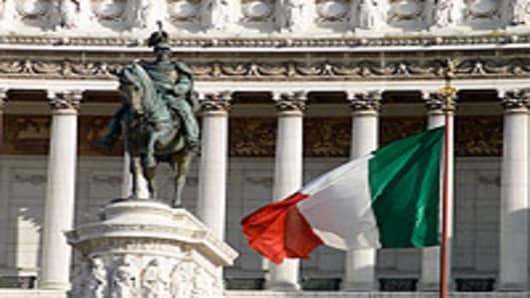Italian interest rates have peaked and will decline to pre-crisis levels as investors become convinced that Italy's finances are back on track, the director general of the Italian Central Bank told CNBC Tuesday.
In an interview, Farbrizio Saccomanni, the No. 2 central banker in Italy, said the measures announced by new Prime Minister Mario Monti this past weekend, will reassure investors the political crisis is over.
“I think it was a peak that was connected mostly to the situation, the political situation in Italy that is now completely changed,” Saccomanni said.
Last week, Italy’s 10-year yield rose to beyond 7 percent, a level that pushed Greece, Portugal, and Ireland to seek bailouts from the European Union when they remained elevated at those levels. But Italian yields have fallen dramatically in the last 2 days after Monti used an emergency decree over the weekend to put in place new taxes, massive budget cuts to regional governments, and higher retirement ages for all Italians.
Many Wall Street analysts believe Italy’s interest rates must fall to 5 percent or lower for the country’s debtto be “sustainable” —that’s economist speak for whether or not a debtor can continue making their payments.
When asked to what levels do Italy’s rates need to fall—Saccomanni rejected the premise all together: I don’t believe that there is any specific level. I don’t believe that also that our levels beyond which you know the debt becomes unsustainable. Our history in the past is that we’ve had debt levels and spread levels much higher than we have now and Italy has always been able to service its debt. My view is that the policies that are now in the pipeline and the decision that have been taken in the last few months are adequate and we expect interest rates will decline and come very close to what they were before the crisis.”
Saccomanni also rejected market rumors that the world’s central banks intervened in the markets last week because there was a bank on the verge of collapse. When the U.S. Federal Reserve lowered the cost of global dollar-swap lines in coordination with other central banks around the world, many in the markets wondered if there was a precipitating event, perhaps a bank on the verge of imminent collapse.
Saccomanni said the rumors are wrong: “No, no, no…this was a concrete example of the kind of cooperation I’m talking about, that in a way, as reversed what was the result of the market, the market decision to withdrawal dollar liquidity from the European market has been put back through these swap lines, so it was not the problem of any individual banks that prompted that, but the feeling that there was sort of a widespread shortage of liquidity.”
Italy's 10-year yield fell to 6.266 percent today, the two-year yield stands at 5.69 percent, and the five-year at 6.14 percent. All skyrocketed to above 7 percent last week.





